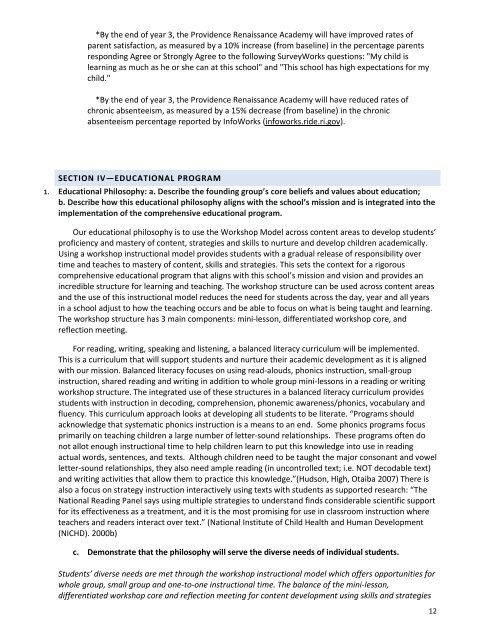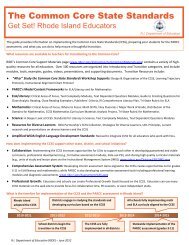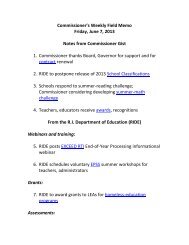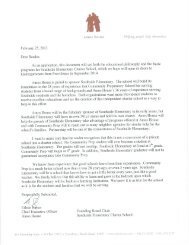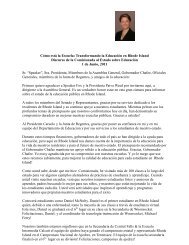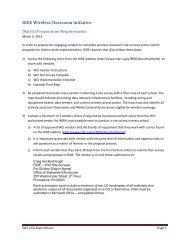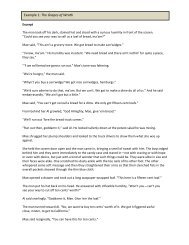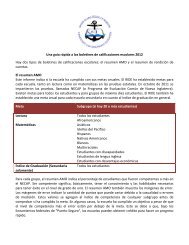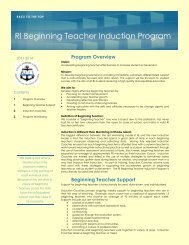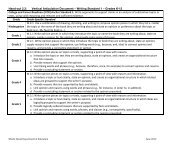Providence Renaissance Academy Charter School - Rhode Island ...
Providence Renaissance Academy Charter School - Rhode Island ...
Providence Renaissance Academy Charter School - Rhode Island ...
Create successful ePaper yourself
Turn your PDF publications into a flip-book with our unique Google optimized e-Paper software.
*By the end of year 3, the <strong>Providence</strong> <strong>Renaissance</strong> <strong>Academy</strong> will have improved rates of<br />
parent satisfaction, as measured by a 10% increase (from baseline) in the percentage parents<br />
responding Agree or Strongly Agree to the following SurveyWorks questions: "My child is<br />
learning as much as he or she can at this school" and "This school has high expectations for my<br />
child."<br />
*By the end of year 3, the <strong>Providence</strong> <strong>Renaissance</strong> <strong>Academy</strong> will have reduced rates of<br />
chronic absenteeism, as measured by a 15% decrease (from baseline) in the chronic<br />
absenteeism percentage reported by InfoWorks (infoworks.ride.ri.gov).<br />
SECTION IV—EDUCATIONAL PROGRAM<br />
1. Educational Philosophy: a. Describe the founding group’s core beliefs and values about education;<br />
b. Describe how this educational philosophy aligns with the school’s mission and is integrated into the<br />
implementation of the comprehensive educational program.<br />
Our educational philosophy is to use the Workshop Model across content areas to develop students’<br />
proficiency and mastery of content, strategies and skills to nurture and develop children academically.<br />
Using a workshop instructional model provides students with a gradual release of responsibility over<br />
time and teaches to mastery of content, skills and strategies. This sets the context for a rigorous<br />
comprehensive educational program that aligns with this school’s mission and vision and provides an<br />
incredible structure for learning and teaching. The workshop structure can be used across content areas<br />
and the use of this instructional model reduces the need for students across the day, year and all years<br />
in a school adjust to how the teaching occurs and be able to focus on what is being taught and learning.<br />
The workshop structure has 3 main components: mini-lesson, differentiated workshop core, and<br />
reflection meeting.<br />
For reading, writing, speaking and listening, a balanced literacy curriculum will be implemented.<br />
This is a curriculum that will support students and nurture their academic development as it is aligned<br />
with our mission. Balanced literacy focuses on using read-alouds, phonics instruction, small-group<br />
instruction, shared reading and writing in addition to whole group mini-lessons in a reading or writing<br />
workshop structure. The integrated use of these structures in a balanced literacy curriculum provides<br />
students with instruction in decoding, comprehension, phonemic awareness/phonics, vocabulary and<br />
fluency. This curriculum approach looks at developing all students to be literate. “Programs should<br />
acknowledge that systematic phonics instruction is a means to an end. Some phonics programs focus<br />
primarily on teaching children a large number of letter-sound relationships. These programs often do<br />
not allot enough instructional time to help children learn to put this knowledge into use in reading<br />
actual words, sentences, and texts. Although children need to be taught the major consonant and vowel<br />
letter-sound relationships, they also need ample reading (in uncontrolled text; i.e. NOT decodable text)<br />
and writing activities that allow them to practice this knowledge.”(Hudson, High, Otaiba 2007) There is<br />
also a focus on strategy instruction interactively using texts with students as supported research: “The<br />
National Reading Panel says using multiple strategies to understand finds considerable scientific support<br />
for its effectiveness as a treatment, and it is the most promising for use in classroom instruction where<br />
teachers and readers interact over text.” (National Institute of Child Health and Human Development<br />
(NICHD). 2000b)<br />
c. Demonstrate that the philosophy will serve the diverse needs of individual students.<br />
Students’ diverse needs are met through the workshop instructional model which offers opportunities for<br />
whole group, small group and one-to-one instructional time. The balance of the mini-lesson,<br />
differentiated workshop core and reflection meeting for content development using skills and strategies<br />
12


